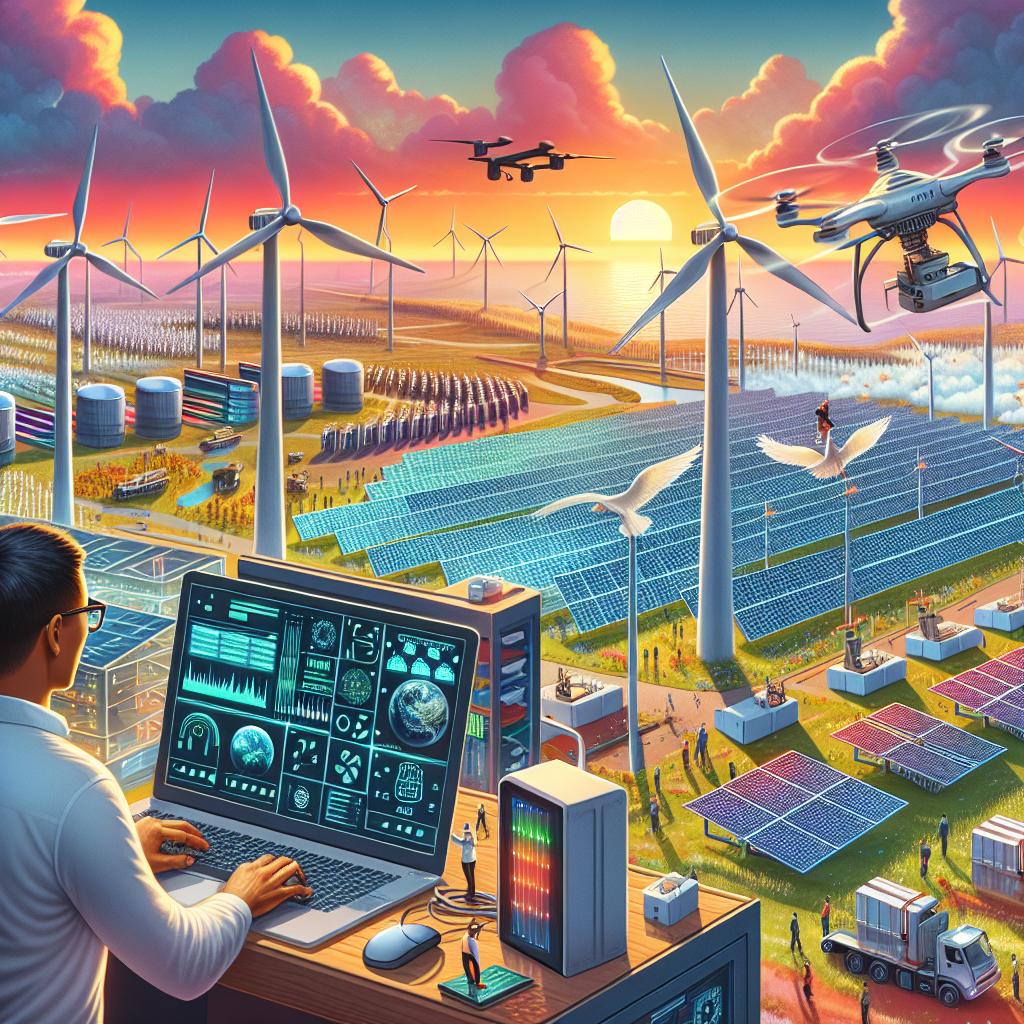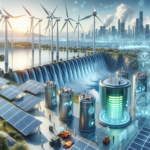-
Table of Contents
“Empowering Tomorrow: Unleashing the Potential of Renewable Energy Storage”
Introduction

The future of renewable energy storage is poised to revolutionize the global energy landscape, addressing one of the most critical challenges in the transition to sustainable power sources. As the world increasingly embraces renewable energy technologies such as solar, wind, and hydropower, the need for efficient, reliable, and scalable energy storage solutions becomes paramount. These storage systems are essential for mitigating the intermittent nature of renewable energy, ensuring a stable and continuous power supply even when the sun isn’t shining or the wind isn’t blowing. Advances in battery technology, such as lithium-ion and emerging solid-state batteries, along with innovative approaches like pumped hydro storage, compressed air energy storage, and hydrogen fuel cells, are at the forefront of this transformation. The integration of smart grid technologies and artificial intelligence further enhances the efficiency and responsiveness of energy storage systems. As research and development continue to drive down costs and improve performance, the future of renewable energy storage promises to unlock the full potential of clean energy, paving the way for a more sustainable and resilient energy future.
Innovations In Battery Technology For Renewable Energy Storage
As the world grapples with the pressing need to transition from fossil fuels to renewable energy sources, the challenge of effectively storing this energy has become increasingly critical. Innovations in battery technology are at the forefront of this transformation, offering promising solutions to one of the most significant hurdles in the renewable energy sector. The ability to store energy efficiently and reliably is essential for ensuring a stable and continuous power supply, especially given the intermittent nature of renewable sources like solar and wind.
One of the most exciting developments in this field is the advent of lithium-ion batteries, which have already revolutionized the consumer electronics market. These batteries are now being scaled up for use in large-scale energy storage systems. Their high energy density, long cycle life, and decreasing costs make them an attractive option for storing renewable energy. However, despite their advantages, lithium-ion batteries are not without their drawbacks. Issues such as thermal runaway, limited availability of raw materials, and environmental concerns related to mining and disposal have spurred researchers to explore alternative technologies.
In response to these challenges, solid-state batteries have emerged as a promising alternative. Unlike traditional lithium-ion batteries, which use a liquid electrolyte, solid-state batteries employ a solid electrolyte. This innovation not only enhances safety by reducing the risk of fires but also potentially increases energy density and extends battery life. Companies and research institutions worldwide are investing heavily in this technology, aiming to overcome the current limitations and bring solid-state batteries to market.
Another noteworthy innovation is the development of flow batteries, which offer a different approach to energy storage. Flow batteries store energy in liquid electrolytes contained in external tanks, allowing for easy scalability and long-duration storage. This makes them particularly well-suited for grid-scale applications where large amounts of energy need to be stored and discharged over extended periods. While flow batteries are still in the early stages of commercialization, their potential to provide stable and reliable energy storage is undeniable.
In addition to these technological advancements, the integration of artificial intelligence (AI) and machine learning into battery management systems is revolutionizing how energy storage systems operate. AI algorithms can optimize charging and discharging cycles, predict maintenance needs, and enhance overall system efficiency. This intelligent management not only prolongs battery life but also ensures that stored energy is used in the most efficient manner possible, thereby maximizing the benefits of renewable energy sources.
Moreover, the concept of second-life batteries is gaining traction as a sustainable solution to the growing issue of battery waste. After their initial use in electric vehicles, batteries often retain a significant portion of their capacity. Repurposing these batteries for energy storage applications can extend their useful life and reduce the environmental impact associated with battery disposal. This approach not only addresses waste management concerns but also provides a cost-effective means of expanding energy storage capacity.
As we look to the future, it is clear that continued innovation in battery technology will play a pivotal role in the global transition to renewable energy. While challenges remain, the progress made thus far is encouraging. By investing in research and development, fostering collaboration between industry and academia, and implementing supportive policies, we can accelerate the deployment of advanced energy storage solutions. In doing so, we move closer to a sustainable energy future where renewable sources can reliably meet our power needs, ensuring a cleaner and more resilient planet for generations to come.
The Role Of Artificial Intelligence In Optimizing Energy Storage Systems
As the world increasingly turns to renewable energy sources like solar and wind to combat climate change, the challenge of efficiently storing this energy has become more pressing. The intermittent nature of these energy sources means that storage systems must be both robust and intelligent to ensure a steady supply of power. Enter artificial intelligence (AI), a technology that is poised to revolutionize the way we manage and optimize energy storage systems.
Artificial intelligence offers a myriad of solutions to the complexities of energy storage. One of the most significant advantages of AI is its ability to predict energy production and consumption patterns with remarkable accuracy. By analyzing vast amounts of data from weather forecasts, historical usage patterns, and even social behavior, AI algorithms can forecast when energy will be produced and when it will be needed. This predictive capability allows for more efficient use of storage systems, ensuring that energy is available when it is most needed and reducing the reliance on fossil fuels during peak demand periods.
Moreover, AI can optimize the operation of energy storage systems in real-time. Traditional energy storage systems often operate on fixed schedules or simple algorithms that do not account for the dynamic nature of energy production and consumption. In contrast, AI can continuously monitor and adjust the operation of these systems, taking into account real-time data and making instantaneous decisions to maximize efficiency. For instance, AI can determine the optimal times to charge and discharge batteries, thereby extending their lifespan and reducing costs.
In addition to optimizing existing storage systems, AI is also driving innovation in the development of new storage technologies. Machine learning algorithms can analyze the performance of different materials and configurations, identifying the most promising options for further research and development. This accelerates the pace of innovation, bringing new and more efficient storage solutions to market more quickly.
Furthermore, AI can facilitate the integration of distributed energy resources, such as rooftop solar panels and home battery systems, into the broader energy grid. By coordinating the operation of these distributed resources, AI can create a more resilient and flexible energy system. This not only enhances the reliability of the grid but also empowers consumers to take a more active role in managing their energy use.
However, the deployment of AI in energy storage is not without its challenges. One of the primary concerns is the need for high-quality data. AI algorithms rely on large datasets to make accurate predictions and decisions, and the quality of these datasets can significantly impact their performance. Ensuring that data is accurate, comprehensive, and up-to-date is crucial for the success of AI-driven energy storage systems.
Another challenge is the integration of AI with existing energy infrastructure. Many current systems were not designed with AI in mind, and retrofitting them to accommodate advanced algorithms can be complex and costly. Nevertheless, the potential benefits of AI in optimizing energy storage systems make it a worthwhile investment.
In conclusion, artificial intelligence holds immense promise for the future of renewable energy storage. By enhancing predictive capabilities, optimizing real-time operations, driving innovation, and facilitating the integration of distributed resources, AI can help overcome some of the most significant challenges associated with renewable energy. While there are hurdles to overcome, the potential for AI to transform energy storage systems and contribute to a more sustainable future is undeniable. As we continue to develop and refine these technologies, the role of AI in optimizing energy storage systems will undoubtedly become even more critical.
The Impact Of Grid-Scale Energy Storage On Renewable Energy Adoption
The future of renewable energy storage is poised to revolutionize the way we harness and utilize clean energy. As the world grapples with the pressing need to reduce carbon emissions and combat climate change, the adoption of renewable energy sources such as solar and wind power has surged. However, the intermittent nature of these energy sources presents a significant challenge. This is where grid-scale energy storage comes into play, offering a promising solution to bridge the gap between energy supply and demand.
Grid-scale energy storage systems, such as large-scale batteries, pumped hydro storage, and advanced flywheels, have the potential to transform the renewable energy landscape. By storing excess energy generated during periods of high production and releasing it during times of low production, these systems can ensure a stable and reliable energy supply. This capability is crucial for the widespread adoption of renewable energy, as it addresses one of the primary concerns: the inconsistency of power generation.
One of the most significant impacts of grid-scale energy storage on renewable energy adoption is its ability to enhance grid stability. Renewable energy sources, while abundant and clean, are inherently variable. Solar power generation peaks during sunny days and drops at night, while wind power is subject to fluctuations based on weather conditions. Without effective storage solutions, these variations can lead to grid instability and power outages. Grid-scale energy storage can mitigate these issues by providing a buffer that smooths out the fluctuations, ensuring a consistent and reliable power supply.
Moreover, grid-scale energy storage can play a pivotal role in reducing the reliance on fossil fuels. Traditionally, fossil fuel-based power plants have been used to provide baseload power and meet peak demand. However, with the integration of large-scale energy storage, renewable energy can take on a more prominent role in the energy mix. Stored renewable energy can be dispatched during peak demand periods, reducing the need for fossil fuel-based power generation and subsequently lowering greenhouse gas emissions.
In addition to enhancing grid stability and reducing fossil fuel reliance, grid-scale energy storage can also lead to economic benefits. By optimizing the use of renewable energy, storage systems can help lower electricity costs for consumers. During periods of high renewable energy production, excess energy can be stored and later sold during peak demand times when electricity prices are higher. This not only provides a financial incentive for energy producers but also helps stabilize electricity prices for consumers.
Furthermore, the development and deployment of grid-scale energy storage technologies can drive innovation and create new job opportunities. As the demand for renewable energy storage solutions grows, so too does the need for skilled workers in research, development, manufacturing, and maintenance. This can lead to the creation of a robust green economy, fostering economic growth while simultaneously addressing environmental concerns.
However, it is important to acknowledge the challenges that come with the widespread implementation of grid-scale energy storage. High initial costs, technological limitations, and regulatory hurdles are some of the obstacles that need to be overcome. Continued investment in research and development, along with supportive policies and incentives, will be crucial in addressing these challenges and unlocking the full potential of grid-scale energy storage.
In conclusion, the impact of grid-scale energy storage on renewable energy adoption cannot be overstated. By providing a reliable and stable energy supply, reducing reliance on fossil fuels, offering economic benefits, and driving innovation, these storage solutions hold the key to a sustainable and clean energy future. As we move forward, it is imperative that we continue to invest in and support the development of grid-scale energy storage technologies to ensure a brighter and greener tomorrow.
Conclusion
The future of renewable energy storage is poised for significant advancements, driven by technological innovations, decreasing costs, and increasing demand for sustainable energy solutions. Breakthroughs in battery technology, such as solid-state batteries and flow batteries, promise higher energy densities, longer lifespans, and improved safety. Additionally, the integration of artificial intelligence and smart grid technologies will enhance the efficiency and reliability of energy storage systems. As renewable energy sources like solar and wind become more prevalent, effective storage solutions will be crucial for ensuring a stable and resilient energy supply, ultimately facilitating the global transition to a low-carbon economy.




